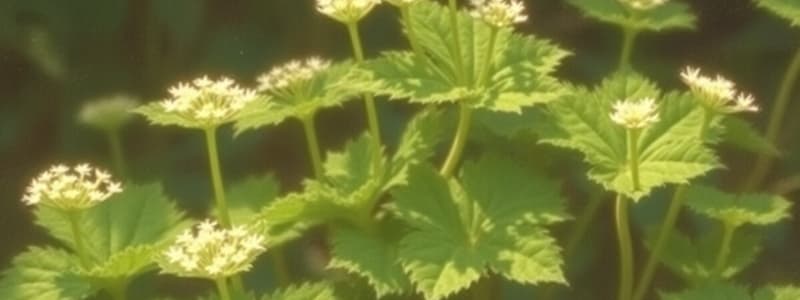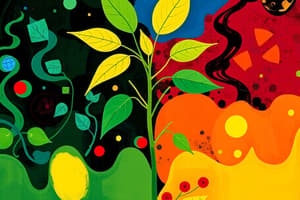Podcast
Questions and Answers
What determines the arrangement of vascular tissues in plants?
What determines the arrangement of vascular tissues in plants?
- Only the type of nutrients available
- The location of the plant only
- Plant classification and location (correct)
- Plant classification and environmental conditions
Which of the following is NOT an essential element for plant growth?
Which of the following is NOT an essential element for plant growth?
- Hydrogen
- Fluorine (correct)
- Oxygen
- Calcium
How do plants adapt to nutrient acquisition based on stress conditions?
How do plants adapt to nutrient acquisition based on stress conditions?
- Increasing leaf surface area
- Altering growth patterns (correct)
- Changing photosynthesis patterns
- Developing deeper roots
Which plant hormone is primarily involved in signaling under stress conditions?
Which plant hormone is primarily involved in signaling under stress conditions?
Which of the following describes a method by which plants can protect themselves from pathogens?
Which of the following describes a method by which plants can protect themselves from pathogens?
What is a notable characteristic of asexual reproduction in flowering plants?
What is a notable characteristic of asexual reproduction in flowering plants?
Where do plants primarily obtain inorganic nutrients needed for growth?
Where do plants primarily obtain inorganic nutrients needed for growth?
Which essential element is primarily responsible for chlorophyll formation in plants?
Which essential element is primarily responsible for chlorophyll formation in plants?
What is the primary function of xylem in plants?
What is the primary function of xylem in plants?
Which of the following substances is NOT directly involved in photosynthesis?
Which of the following substances is NOT directly involved in photosynthesis?
What role do root nodules play in plants?
What role do root nodules play in plants?
Which part of the phloem conducts manufactured food from one cell to another?
Which part of the phloem conducts manufactured food from one cell to another?
What is the primary process by which plants transport manufactured food?
What is the primary process by which plants transport manufactured food?
Which of the following statements about vascular tissues is TRUE?
Which of the following statements about vascular tissues is TRUE?
What characteristic distinguishes parenchyma cells in the phloem?
What characteristic distinguishes parenchyma cells in the phloem?
Which vascular tissue primarily facilitates the absorption of water from the soil?
Which vascular tissue primarily facilitates the absorption of water from the soil?
What is one key difference between natural and artificial vegetative propagation?
What is one key difference between natural and artificial vegetative propagation?
Which of the following methods involves planting cut parts of a plant to grow new individuals?
Which of the following methods involves planting cut parts of a plant to grow new individuals?
What type of plant structure does a runner represent?
What type of plant structure does a runner represent?
Which of the following is NOT a method of artificial vegetative propagation?
Which of the following is NOT a method of artificial vegetative propagation?
In which reproductive method do new bulbs arise from an auxiliary bud on very short stems?
In which reproductive method do new bulbs arise from an auxiliary bud on very short stems?
Which of the following represents a method that uses a piece of tissue placed on a sterile medium to grow new plants?
Which of the following represents a method that uses a piece of tissue placed on a sterile medium to grow new plants?
Which structure is defined by new plants arising from nodes of a horizontal rootlike underground stem?
Which structure is defined by new plants arising from nodes of a horizontal rootlike underground stem?
Which of the following is commonly associated with grafting?
Which of the following is commonly associated with grafting?
What type of flower has both male and female reproductive organs present in the same flower?
What type of flower has both male and female reproductive organs present in the same flower?
What part of the flower is responsible for producing pollen?
What part of the flower is responsible for producing pollen?
Which of the following is NOT a non-reproductive part of a flower?
Which of the following is NOT a non-reproductive part of a flower?
What process involves the transfer of pollen grains from the anther to the stigma?
What process involves the transfer of pollen grains from the anther to the stigma?
During which stage do the male gametes travel down the pollen tube?
During which stage do the male gametes travel down the pollen tube?
Which non-reproductive part of the flower helps protect the flower before it blooms?
Which non-reproductive part of the flower helps protect the flower before it blooms?
What is the primary purpose of seed dispersal in plants?
What is the primary purpose of seed dispersal in plants?
What conditions are required for a seed to germinate?
What conditions are required for a seed to germinate?
Flashcards
Photosynthesis
Photosynthesis
The process by which plants convert inorganic substances (water and CO2) into organic forms (O2 and glucose) using sunlight.
Water Absorption
Water Absorption
The absorption of water and nutrients from the soil through the roots.
Root Nodules
Root Nodules
A symbiotic relationship between legumes and bacteria, where bacteria convert nitrogen gas into ammonia, which is a usable form of nitrogen for plants.
Xylem
Xylem
Signup and view all the flashcards
Vessels (in Xylem)
Vessels (in Xylem)
Signup and view all the flashcards
Phloem
Phloem
Signup and view all the flashcards
Sieve Tubes
Sieve Tubes
Signup and view all the flashcards
Companion Cells
Companion Cells
Signup and view all the flashcards
Vegetative Propagation
Vegetative Propagation
Signup and view all the flashcards
Artificial Vegetative Propagation
Artificial Vegetative Propagation
Signup and view all the flashcards
Runner
Runner
Signup and view all the flashcards
Rhizome
Rhizome
Signup and view all the flashcards
Corm
Corm
Signup and view all the flashcards
Tuber
Tuber
Signup and view all the flashcards
Bulb
Bulb
Signup and view all the flashcards
Cutting
Cutting
Signup and view all the flashcards
Plant Nutrition
Plant Nutrition
Signup and view all the flashcards
Plant Nutrients/Essential Elements
Plant Nutrients/Essential Elements
Signup and view all the flashcards
17 Essential Elements for Plants
17 Essential Elements for Plants
Signup and view all the flashcards
Vascular Tissue Arrangement
Vascular Tissue Arrangement
Signup and view all the flashcards
Asexual Reproduction in Flowering Plants
Asexual Reproduction in Flowering Plants
Signup and view all the flashcards
Plant Hormones
Plant Hormones
Signup and view all the flashcards
Adaptive Mechanisms for Nutrient Acquisition
Adaptive Mechanisms for Nutrient Acquisition
Signup and view all the flashcards
Defense Mechanisms against Pathogens
Defense Mechanisms against Pathogens
Signup and view all the flashcards
Pollination
Pollination
Signup and view all the flashcards
Fertilization
Fertilization
Signup and view all the flashcards
Seed Dispersal
Seed Dispersal
Signup and view all the flashcards
Germination
Germination
Signup and view all the flashcards
Petals
Petals
Signup and view all the flashcards
Sepals
Sepals
Signup and view all the flashcards
Receptacle
Receptacle
Signup and view all the flashcards
Peduncle
Peduncle
Signup and view all the flashcards
Study Notes
Plant Form & Function
- Plants require sunlight, water, nutrients from soil, and air for growth.
- Plants absorb nutrients as inorganic substances (water and CO2) and convert them into organic form (O2 and glucose) through photosynthesis.
Importance of Water
- Water is vital for plant survival.
- Plants have specialized root hairs to maximize water absorption from the soil.
- Roots absorb micronutrients and compounds from the surrounding soil.
Root Nodules
- Root nodules in legumes are symbioses between legumes and leguminous bacteria.
- They convert nitrogen gas into ammonia.
Transport System in Plants
- Vascular tissues transport substances throughout the plant.
- The main vascular tissues are xylem and phloem.
Xylem
- Xylem transports water and minerals from roots to other plant parts.
- Some xylem parts lack protoplasm and cell walls, facilitating easy water and mineral transport.
- Xylem contains tracheids and vessels.
- Tracheids are connected through pitted walls, but water flow is not continuous.
- Vessels are hollow, wider tubes stretching from roots to leaves.
- Xylem fibers provide structural support.
- Xylem parenchyma is the only living cell that supports food storage.
Lignin
- Xylem tissues are strengthened by lignin.
- Lignin patterns vary depending on location (e.g., annular, spiral, etc.).
Phloem
- Phloem transports manufactured food (sucrose and amino acids) from leaves to other parts of the plant.
- This process is called translocation.
- Phloem contains sieve tube members and companion cells.
- Sieve tube members are elongated, thin-walled cells with sieve pores.
- Companion cells are alive, with abundant cytoplasm and nucleus. supporting metabolic activities of sieve tube members.
Plant Classification
- Plant vascular tissue arrangements differ based on location (root, stem, leaf) and plant classification (monocot or dicot).
Plant Nutrition
- Plant nutrition refers to the supply and absorption of chemical compounds (essential nutrients) needed for growth.
- Plants absorb essential nutrients from soil, air, and water.
- A list of 17 essential elements for plants is provided (Carbon, Hydrogen, Oxygen, Nitrogen, etc.).
Adaptive Mechanisms in Plants
- Plants employ adaptive mechanisms to adjust growth depending on nutrient availability.
- They alter growth patterns and change metabolic pathways to respond to stress conditions.
- Plants employ protective barriers (physical and chemical) against pathogens.
Asexual Reproduction in Flowering Plants
- Many plants reproduce asexually through vegetative parts (stem, roots, leaves).
- Asexually produced plants are genetically identical to the parent plant.
- Methods of asexual propagation include natural vegetative propagation (e.g., runners, rhizomes, corms, tubers, bulbs) and artificial methods (e.g., cuttings, budding, grafting, tissue culture).
Modified Stems
- Runners, rhizomes, corms, tubers, and bulbs are examples of modified stems used in asexual reproduction.
- Different types of modified stems have unique descriptions and representative species. (e.g., runner – Bermuda grass, rhizome – sugarcane).
Sexual Reproduction in Flowering Plants
- Flowering plants reproduce sexually.
- Reproductive organs are located in flowers.
- Flowers can be perfect (hermaphrodites) or imperfect.
- Perfect flowers have both male and female reproductive organs.
- Imperfect flowers have male and female reproductive organs in separate flowers.
Parts of a Flower
- Petals attract pollinators.
- Sepal protects the flower before blooming.
- Receptacle holds the flower's organs.
- Peduncle (flower stalk) holds the flower itself.
- Stamens (male) consist of anthers that produce pollen (male sex cells) and filaments that support the anther.
- Pistil (female) consists of stigma (sticky surface to trap pollen), style (connects stigma and ovary), and ovary (contains ovules).
Stages of Sexual Reproduction
- Pollination: transfer of pollen grains from anther to stigma.
- Self-pollination - pollen transferred on the same plant.
- Cross-pollination - pollen transferred to a different plant.
- Fertilization: pollen tube grows to penetrate the ovule, initiating fertilization.
- Seed dispersal: prevents overcrowding and competition, helps in plant expansion.
- Germination: seed development into a new plant, requires sufficient water, oxygen and warmth.
Studying That Suits You
Use AI to generate personalized quizzes and flashcards to suit your learning preferences.




